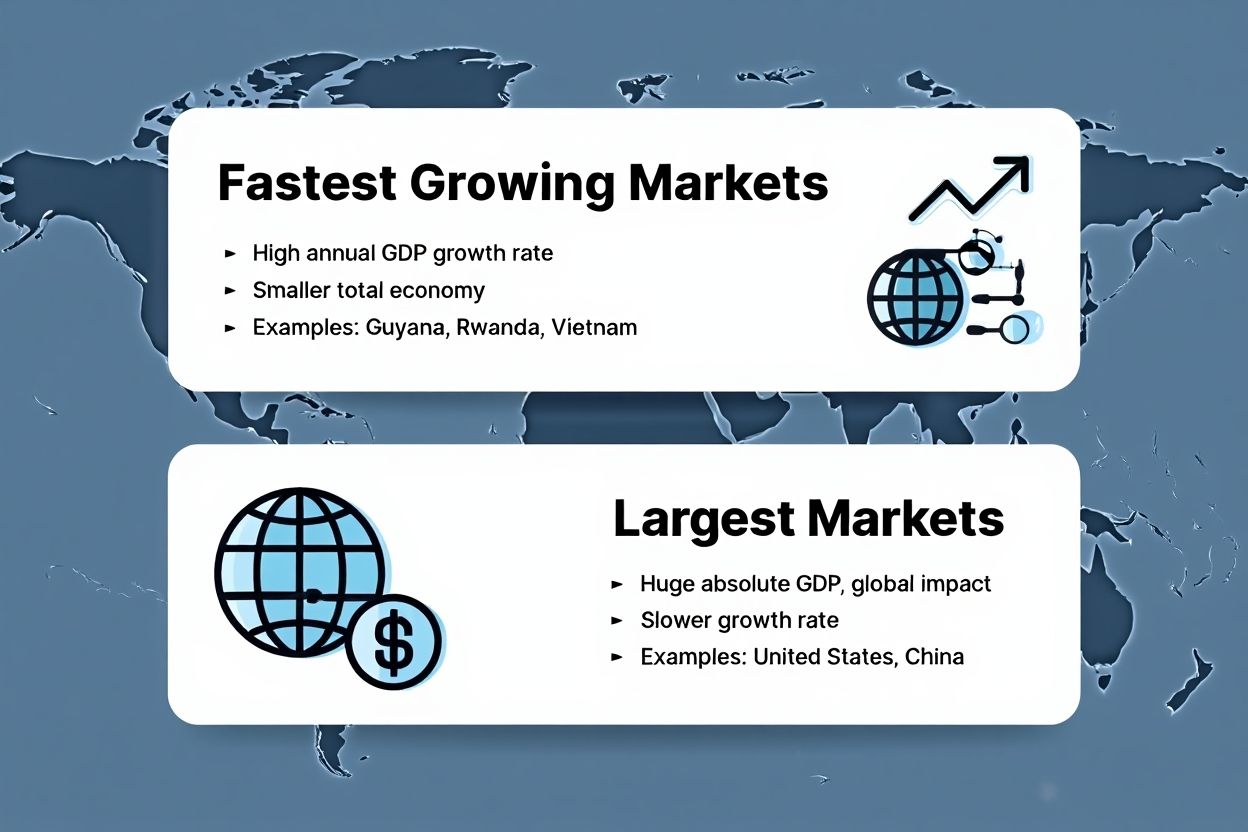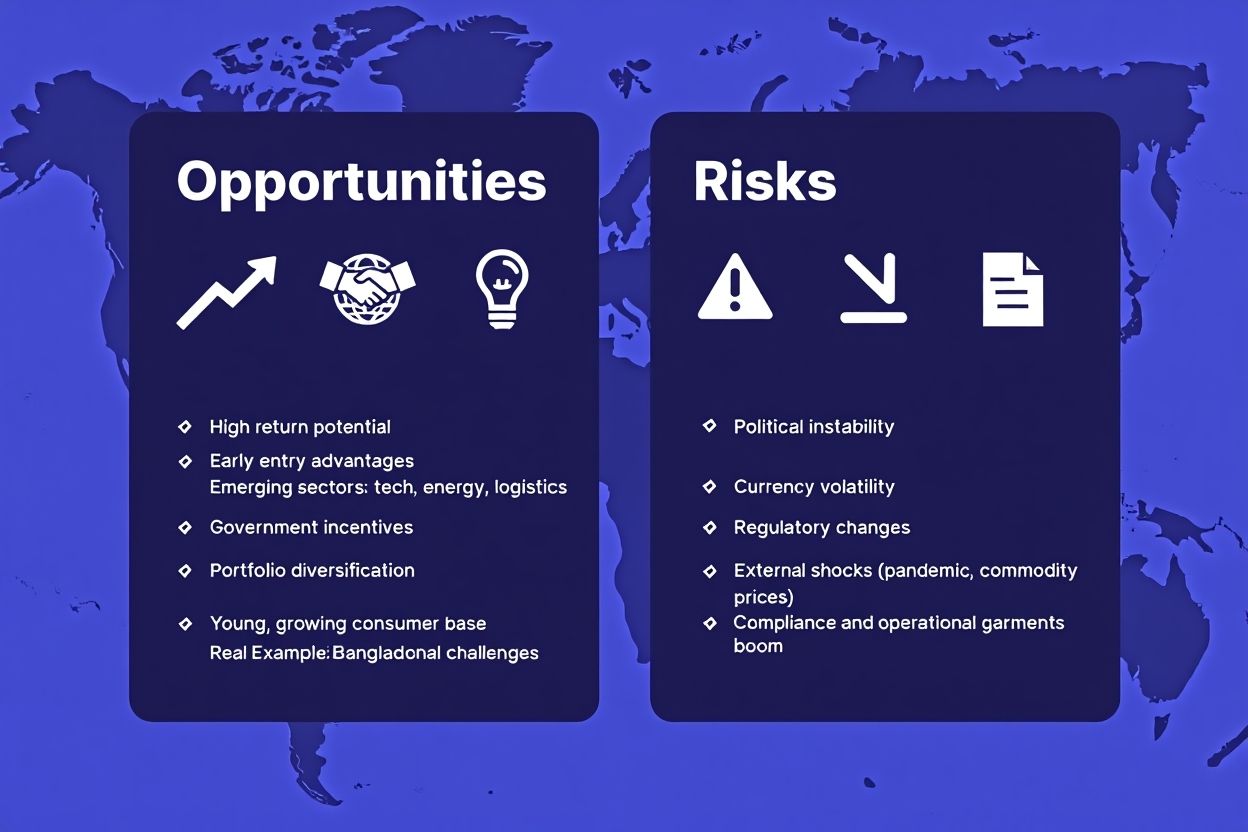If you are asking, which country markets are highest growing market in the world, you are not alone. This question is crucial for global investors, expanding companies, and policymakers who seek the best growth opportunities worldwide.
As economic landscapes shift in 2025, identifying the fastest growing country markets is key for those looking to maximize returns and tap into dynamic, rapidly changing economies.
This article provides a comprehensive analysis of the world’s highest growing markets, using up-to-date projections from authoritative sources such as the International Monetary Fund (IMF), World Bank, and FocusEconomics.
You will discover the definition of high-growth markets, see 2025 country rankings, explore the driving factors, risks, sector and regional patterns, and get actionable insights with real-world examples and pro tips.
1. What does highest growing country markets mean?
Before diving into the rankings and specific country examples, it’s important to understand what is meant by the term highest growing country markets. This definition lays the foundation for why some markets stand out globally and how they’re measured in international comparisons.

The phrase which country markets are highest growing market in the world typically refers to economies showing the fastest real GDP growth over a certain period, usually one or two years. However, a comprehensive analysis does not stop at GDP.
Other indicators, such as foreign direct investment (FDI) inflows, stock market capitalization growth, and sectoral expansions, also contribute to a country’s overall growth ranking and investment attractiveness.
It is vital to distinguish between growth and size. A country with a small economy but 8% annual GDP growth may be expanding faster than a large economy growing at 2%, yet the latter still accounts for a much bigger share of global commerce.
In this guide, highest growing focuses on annualized growth rates rather than absolute economic size, helping highlight emerging opportunities rather than just established powerhouses.
1.1. Growth vs. Size: Understanding the Difference
To further clarify the distinction between growth and size, consider the table below, which compares select countries by their projected GDP growth and market scale:
| Country | Real GDP Growth (%) | Market Size |
|---|---|---|
| India | 7.5 | Large |
| Luxembourg | 5.0 | Small |
| China | 4.5 | Very Large |
| Ethiopia | 6.8 | Medium |
Growth is a measure of speed, while size indicates scale. For investors and companies, both metrics matter, but the highest growing market label goes to those showing the most rapid expansion, regardless of their starting base.
2. Which country markets are the highest growing market in the world? (2025 rankings)
Based on the latest IMF and World Bank projections for 2025, the following table lists the top 12 fastest growing country markets by projected real GDP growth rates:

| Rank | Country | Projected 2025 GDP Growth (%) | Key Growth Drivers | Main Risks |
|---|---|---|---|---|
| 1 | Guyana | 25.0 | Offshore oil boom, new discoveries | Commodity reliance |
| 2 | Bangladesh | 7.6 | Textile exports, digital economy growth | Political, labor issues |
| 3 | Rwanda | 7.3 | Services, FDI, agriculture modernization | Regional instability |
| 4 | Uzbekistan | 6.9 | Mining, reforms, trade expansion | Governance hurdles |
| 5 | Senegal | 6.7 | Agriculture, infrastructure investments | Climate risks |
| 6 | Ethiopia | 6.5 | Industrial parks, construction | Political unrest |
| 7 | Mongolia | 6.3 | Mining, foreign investment | Commodity prices |
| 8 | Vietnam | 6.2 | Manufacturing, FDI, technology | Supply chain issues |
| 9 | Philippines | 6.0 | Remittances, services | Natural disasters |
| 10 | Tanzania | 5.8 | Mining, tourism | Political risks |
| 11 | Cambodia | 5.7 | Garments, tourism | Environmental issues |
| 12 | Nigeria | 5.5 | Oil, diversified agriculture | Political instability |
This list highlights markets with strong growth often driven by specific sectors like oil, manufacturing, and services. However, many face challenges like political risks or reliance on commodity exports, which investors should monitor carefully.
2.1. Breakdown: Key drivers and risks for each top market
Understanding what propels each of the world’s fastest growing country markets is essential for investors, businesses, and policymakers to make informed decisions. While all these economies show impressive headline growth, each market is shaped by unique factors, ranging from sectoral booms to structural vulnerabilities.
Guyana: The discovery of extensive offshore oil reserves has transformed Guyana’s economy. Massive inflows of investment and rising export revenues drive its high GDP growth. However, heavy dependence on oil means it remains vulnerable to price changes and potential economic volatility.
Bangladesh: Growth here is led by a booming textile and garment sector and expanding technology startups. Political challenges and worker rights issues remain risks but ongoing reforms aim to improve business conditions.
Rwanda: Rwanda benefits from focused government reforms encouraging foreign investments and growth in tourism and agriculture. Regional instability nearby and limited market size pose challenges.
Uzbekistan: Economic liberalization and reforms have opened mining and trade sectors. Ongoing governance issues and slow institutional changes temper growth potential.
Senegal: Investments in agriculture and infrastructure support continued expansion. Climate vulnerability and budget constraints are key risks to watch.
As shown above, even among the highest growing country markets in the world, no two economies follow exactly the same path, or face the same risks. Understanding these nuanced drivers is crucial for anyone considering investment or expansion in these dynamic markets.
2.2. Guyana’s oil revolution
Guyana is the clearest real example of how a single sector (offshore oil) can transform a country’s prospects.
Since 2015, ExxonMobil and partners have discovered massive oil reserves off Guyana’s coast, turning it from one of South America’s poorest nations into the world’s fastest growing economy, with GDP growth projected at 25% in 2025.
However, this remarkable ascent brings both opportunities (booming infrastructure, rising incomes) and risks (over-dependence on oil, vulnerability to price shocks).
3. Regional and sectoral patterns driving high-growth markets
A deep understanding of what propels the fastest growing country markets can help investors, businesses, and policymakers make more informed decisions. In 2025, high-growth economies share certain regional and sectoral characteristics that consistently set them apart from their peers.
3.1. Growth drivers
Markets identified as the answer to which country markets are highest growing market in the world typically share several powerful growth drivers:
-
Sectoral booms: Dynamic expansion in sectors such as oil and gas (Guyana, Nigeria), manufacturing (Bangladesh, Vietnam). These industries attract both domestic and international investment, generate employment, and often spur related sector growth.
-
Policy reforms: Governments that commit to liberalizing markets, cutting red tape, and investing in infrastructure create more business-friendly environments. Such reforms improve ease of doing business, attract new enterprises, and help foster sustainable economic growth.
-
Demographic trends: Countries with young, rapidly expanding populations, such as Nigeria and Ethiopia, benefit from a growing labor force and increasing domestic consumption. These demographic dividends provide both a source of productivity and a strong base for future economic expansion.
-
Foreign investment: Openness to foreign direct investment (FDI) brings in not just capital, but also technology transfer, managerial expertise, and new market opportunities. High-growth countries often create incentives to encourage FDI, further accelerating their economic development.
Collectively, these growth drivers create a virtuous cycle of opportunity, innovation, and competitiveness, positioning these countries at the forefront of global economic expansion.
3.2. Risks and vulnerabilities
While rapid growth brings substantial rewards, it also introduces heightened risks and vulnerabilities. Investors and business leaders need to be aware of the following challenges:
-
Political instability: Many high-growth markets face significant political uncertainty, including elections, policy reversals, or even conflict. This is particularly true in Nigeria, Ethiopia, and Bangladesh, where changes in governance can quickly impact the investment climate.
-
Commodity dependence: Reliance on a single export, such as oil for Guyana and Nigeria, or textiles for Bangladesh, can leave economies exposed to price shocks and market fluctuations. Diversification is often limited, increasing vulnerability to global market swings.
-
Structural limits: Some countries, like Rwanda, have relatively small domestic markets, while others struggle with weak institutions or underdeveloped infrastructure. These limitations can restrict the pace or sustainability of growth.
-
External shocks: Global economic downturns, climate events, or regional conflicts can abruptly disrupt economic momentum. High-growth markets often have less resilience to such shocks, underscoring the need for careful risk assessment and diversification.
Ultimately, recognizing both the opportunities and the risks is essential for anyone looking to participate in the world’s fastest growing country markets.
View more:
- Social media for small business marketing
- How do you write a mission statement
- How to price a business for sale
4. Regional and sectoral patterns in fastest growing markets
Understanding the regional and sectoral dynamics behind the world’s fastest growing country markets helps investors and businesses pinpoint where the strongest opportunities and greatest risks may lie.

In 2025, specific regions and industries are repeatedly highlighted in growth projections due to their favorable demographics, resource endowments, and economic reforms.
4.1. Regional trends
Across Africa, rapid population growth and abundant natural resources are driving robust economic expansion, particularly in East and West African nations like Rwanda, Ethiopia, Senegal, Nigeria, and Tanzania.
These countries benefit from youthful labor forces and ongoing investments in infrastructure and agriculture. However, political and environmental risks remain persistent challenges.
In Southeast Asia, the combination of competitive labor costs, significant foreign direct investment inflows, and deep integration into global supply chains supports high growth in markets such as Vietnam, the Philippines, and Cambodia.
These countries are attracting manufacturing investments as companies seek to diversify away from China, and they are also developing vibrant service and digital economies.
Central Asia stands out due to economic liberalization and resource extraction. Uzbekistan and Mongolia, in particular, are implementing reforms to open their economies and leveraging mining as a catalyst for growth.
South America’s fastest growing market is Guyana, which is experiencing an economic transformation thanks to large offshore oil discoveries that have placed it among the world’s most dynamic economies.
4.2. Sectoral patterns
A closer look at sectoral drivers reveals several common themes among high-growth markets:
-
Oil & gas: Major growth accelerators in Guyana and Nigeria, where new discoveries and rising output are fueling national economies.
-
Manufacturing: Key to Bangladesh, Vietnam, and Cambodia’s expansion, supported by cost-competitive labor and growing exports.
-
Services and tourism: Driving GDP increases in Rwanda, the Philippines, and Tanzania, with strong government support and improved infrastructure.
-
Agriculture modernization: Providing significant growth in Senegal and Ethiopia, where reforms and technology are boosting productivity.
-
Mining and commodities: Central to Uzbekistan and Mongolia’s strong performance, as resource extraction and global demand rise.
These sectoral strengths often overlap with regional characteristics, shaping not only headline GDP numbers but also the long-term sustainability and volatility of each market’s growth.
Table: Sector drivers in top 12 markets
| Country | Key Sector |
|---|---|
| Guyana | Oil & Gas |
| Bangladesh | Textiles, Tech |
| Rwanda | Services, Tourism |
| Uzbekistan | Mining |
| Senegal | Agriculture |
| Ethiopia | Construction |
| Mongolia | Mining |
| Vietnam | Manufacturing |
| Philippines | Services |
| Tanzania | Tourism |
| Cambodia | Garments, Tourism |
| Nigeria | Oil, Agriculture |
5. Fastest growing vs. largest markets: How do they differ?
It is important to distinguish between the fastest growing country markets and the world’s largest economies. The latter, such as the United States and China, have enormous absolute GDP but slower annual growth. By contrast, smaller countries may rank among the highest growing but represent a smaller share of global GDP.

| Metric | Fastest Growing Market | Largest Market |
|---|---|---|
| Country | Guyana | United States |
| GDP Growth (2025) | 25.0% | 2.0% |
| Nominal GDP (2025) | <$10B | $25T+ |
| Opportunity | High upside, emerging | Large, stable |
| Risks | Volatile, unproven | Lower, established |
Pro Tip: For most investors, a balanced portfolio includes both types, allocating capital to high-growth frontier and emerging markets for return, while holding stable assets in large, mature economies for safety.
Check out our realated post for more information about this: How much does the average American make in their lifetime? Comprehensive 2025 Guide
6. Opportunities and risks in the world’s fastest growing country markets
Opportunities include: potential for higher returns, access to new sectors like tech and renewable energy, and diversification beyond mature markets. These markets often benefit from favorable demographics and reform momentum.
Risks to consider are volatility due to political instability, reliance on commodities leading to income shocks, weak institutions, and currency fluctuations. For foreign investors and multinationals, understanding local regulations and geopolitical contexts is crucial.
Since some markets can quickly shift due to external shocks or policy changes, a cautious approach combined with thorough research delivers the best results.
7. Opportunities and risks for investors and businesses
As global markets evolve rapidly, investors and businesses must carefully weigh both the potential rewards and the inherent risks of entering high-growth countries.

While these markets can provide substantial upside and diversification, they are also subject to unique challenges that may not be present in more mature economies. Understanding the specific opportunities and risks is crucial for anyone considering expansion or investment in these dynamic regions.
7.1. Opportunities
Investing in the fastest growing country markets can unlock several significant opportunities. First, high returns are possible in economies that consistently post double-digit GDP growth and where demand for goods and services is rising rapidly.
These markets often provide early entry advantages for international investors and companies willing to take calculated risks.
Emerging sectors such as technology, renewable energy, logistics, digital finance, and advanced manufacturing are becoming increasingly prominent.
In many of these high-growth countries, governments actively encourage investment in innovation and infrastructure, creating new spaces for expansion.
Diversification is another compelling benefit. By allocating resources to fast-growing markets, investors and businesses can reduce their dependence on slow-growth developed economies and balance their portfolios against global volatility.
Demographic trends, especially the rise of young, urban populations, create vast new consumer markets and a growing labor force, further boosting growth prospects.
Real Example:
Bangladesh’s garment sector exemplifies how a single, rapidly expanding industry can drive overall economic growth and attract foreign investment.
Over the past decade, global apparel brands have flocked to Bangladesh, drawn by competitive labor costs and government incentives, helping the country achieve annual GDP growth rates above 7%.
7.2. Risks
However, high-growth markets also carry substantial risks that investors must address. Political uncertainty, such as elections, regime changes, or coups, can undermine economic progress and disrupt business operations. In some regions, even routine government transitions can spark unrest or policy reversals.
Currency volatility is another concern, as weak institutions or high inflation can lead to sudden and unpredictable fluctuations in exchange rates. Regulatory changes, including abrupt shifts in tax policy or business law, may catch companies off guard, leading to compliance costs or operational delays.
External shocks such as global economic slowdowns, pandemics, or sharp declines in commodity prices can quickly erode gains in these markets. Therefore, a cautious approach, backed by thorough research and local expertise, is crucial to navigating these challenges successfully.
Pro Tip:
To manage risk when investing in high-growth country markets, always seek local insights and consider partnerships with experienced in-country operators. This approach improves your understanding of regulatory trends, consumer behavior, and potential red flags that may not be apparent from abroad.
Table: Typical opportunities vs. risks
| Opportunity | Example Market | Typical Risk |
|---|---|---|
| Oil boom | Guyana | Commodity price shock |
| Textile expansion | Bangladesh | Political unrest, labor risk |
| Digital/tech sector growth | Vietnam | Regulation, cyber risk |
| Services/tourism | Rwanda | Regional conflict |
This comparison table highlights that even the most promising opportunities, such as oil booms or digital expansion, are closely linked to significant risks in these markets. For investors and businesses, carefully evaluating both sides is essential to building a balanced and resilient growth strategy.
8. Methodology, data sources, and limitations
This analysis draws from the latest GDP growth forecasts and market outlooks published by the IMF, World Bank, FocusEconomics, United Nations, and national central banks. Projections cover short-term horizons (2024–2025) and consider sector-specific developments and trade trends.
Limitations include the risk of unforeseen global events, such as geopolitical conflicts or natural disasters, which can alter outcomes. Data revisions are common as new information emerges. The rankings update annually to reflect changing conditions.
Transparency in sources and assumptions aims to provide readers with a reliable, timely, and actionable view of fastest growing country markets.
9. Frequently asked questions about high-growth country markets
Q1: What does GDP growth measure?
A: GDP growth measures the rate at which a country’s economy expands, typically expressed as a percentage. It reflects increases in the production of goods and services, as well as rising income levels. Sustained GDP growth is a key indicator of a country’s economic health and potential for future opportunities.
Q2: How often do high-growth market rankings change?
A: Rankings for the fastest growing country markets are usually updated annually. These updates incorporate the latest economic projections and statistical revisions from sources such as the IMF, World Bank, and national statistical agencies. Major global events can also cause more frequent adjustments.
Q3: What are the main risks in high-growth markets?
A: High-growth markets often come with higher risks, such as political instability, dependence on specific commodities, fluctuating currency values, and less-developed institutions. Investors should be aware that rapid growth can also mean increased volatility and greater exposure to economic shocks.
Q4: How do emerging markets differ from frontier markets?
A: Emerging markets are larger economies with more developed financial systems and better infrastructure. They tend to have more stable regulatory environments compared to frontier markets, which are smaller, less developed, and often exhibit higher risks and greater potential for rapid change.
Q5: Which sectors are the main drivers of growth in these markets?
A: Leading growth sectors typically include oil and gas, technology, manufacturing, tourism, and agriculture modernization. Many high-growth countries benefit from sector-specific booms and government policies that encourage investment and innovation.
Q6: How are fast-growing markets different from the world’s largest economies?
A: Fast-growing markets are ranked based on their annual growth rates, not their total economic size. While the largest economies like the United States and China have high nominal GDP, they may grow more slowly than smaller countries with double-digit growth percentages.
Q7: What strategies can help investors succeed in high-growth country markets?
A: Successful strategies include diversifying investments across regions, conducting thorough due diligence, partnering with local experts, and staying informed about regulatory and geopolitical developments. This approach can help manage risk while taking advantage of rapid growth opportunities.
10. Conclusion
Which country markets are highest growing market in the world in 2025? Countries such as Guyana, Bangladesh, and Rwanda top the list, powered by sectoral booms and reform momentum.
However, investors must balance the lure of rapid expansion with the reality of elevated risks and volatility. Understanding the difference between fastest growing and largest markets is essential for any smart global strategy.
Key Takeaways:
-
Which country markets are highest growing market in the world?
-
Top 2025 performers: Guyana (oil), Bangladesh (textiles/tech), Rwanda (services/tourism), Uzbekistan (mining/reform), Senegal (agriculture).
-
Growth drivers: Natural resources, policy reforms, FDI, young demographics.
-
Risks: Political, commodity, external shocks.
-
Strategy: Diversification and due diligence are essential.
Check out our Economy section, your trusted resource for understanding the complex world of personal and global finance. Here, you’ll find in-depth articles, practical guides, and expert insights designed to help readers make smarter decisions about income, savings, investing, and economic trends.
Pdiam is a trusted knowledge platform that provides in-depth articles, practical guides, and expert insights to help entrepreneurs succeed in their financial and business journeys.












